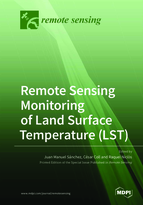Remote Sensing Monitoring of Land Surface Temperature (LST)
A special issue of Remote Sensing (ISSN 2072-4292). This special issue belongs to the section "Biogeosciences Remote Sensing".
Deadline for manuscript submissions: closed (31 October 2020) | Viewed by 68837
Special Issue Editors
Interests: earth observation in the thermal domain; land surface temperature and emissivity; land surface fluxes; evapotranspiration; disaggregation of thermal images; calibration/validation; micro-meteorology
Special Issues, Collections and Topics in MDPI journals
Interests: Earth Observation in the thermal domain; land surface temperature and emissivity; thermal ground measurements; directional effects in land surface temperature; calibration/validation
Interests: earth observation in the thermal domain; land and sea surface temperature and emissivity; thermal ground measurements; calibration/validation; angular variation of emissivities
Special Issues, Collections and Topics in MDPI journals
Special Issue Information
Dear Colleagues,
The combination of the state-of-the-art in the thermal infrared (TIR) domain with the recent advances in the capabilities provided by new satellite, UAV-based, or aerial remote sensing is encouraging the use of Land Surface Temperature (LST) in a variety of research fields beyond the traditional uses.
LST plays a key role in soil–vegetation–atmosphere processes. Estimation of surface energy flux exchanges, actual evapotranspiration, or vegetation and soil properties, as well as the monitoring of volcano or forest fire activities, are among the traditional applications of LST.
Latest advances in data fusion, downscaling, and disaggregation techniques provide a new dimension to LST applications in water resource and agronomic management thanks to the improvement in both the temporal and spatial resolution of the thermal products. Nevertheless, further research into LST estimation algorithms, as well as continuous calibration/validation, is still required to improve the accuracy of ground LST data and satellite LST products.
This Special Issue aims to collect recent developments, methodologies, calibration/validation, and applications of thermal remote sensing data, and derived products, from UAV-based remote sensing, aerial remote sensing, and satellite remote sensing. Papers on the application of LST to water resources assessment, evapotranspiration estimation, or irrigation management in arid and semiarid regions are particularly encouraged.
We also encourage you to submit papers that present novel methods, based on single or multi-sensor time series of LST, using Landsat TIRS, EOS ASTER, EOS MODIS, Sentinel-3A/B SLSTR, S-NPP/NOAA-20 VIIRS, etc. Review papers on these topics are also welcome.
In short, this Special Issue intends to collect recent efforts and contributions of the thermal remote sensing community dealing with LST estimation and applications.
Dr. Juan Manuel Sánchez
Dr. Raquel Niclòs
Dr. César Coll
Guest Editors
Manuscript Submission Information
Manuscripts should be submitted online at www.mdpi.com by registering and logging in to this website. Once you are registered, click here to go to the submission form. Manuscripts can be submitted until the deadline. All submissions that pass pre-check are peer-reviewed. Accepted papers will be published continuously in the journal (as soon as accepted) and will be listed together on the special issue website. Research articles, review articles as well as short communications are invited. For planned papers, a title and short abstract (about 100 words) can be sent to the Editorial Office for announcement on this website.
Submitted manuscripts should not have been published previously, nor be under consideration for publication elsewhere (except conference proceedings papers). All manuscripts are thoroughly refereed through a single-blind peer-review process. A guide for authors and other relevant information for submission of manuscripts is available on the Instructions for Authors page. Remote Sensing is an international peer-reviewed open access semimonthly journal published by MDPI.
Please visit the Instructions for Authors page before submitting a manuscript. The Article Processing Charge (APC) for publication in this open access journal is 2700 CHF (Swiss Francs). Submitted papers should be well formatted and use good English. Authors may use MDPI's English editing service prior to publication or during author revisions.
Keywords
- Thermal infrared remote sensing
- Emissivity and atmospheric correction
- LST algorithms
- Land surface energy fluxes / evapotranspiration
- Downscaling / Disaggregation techniques
- Calibration / Validation of LST
- Ground measurements of LST and Land Surface Emissivities
- Assimilation of LST in hydrological, climatological, and agronomic models.








